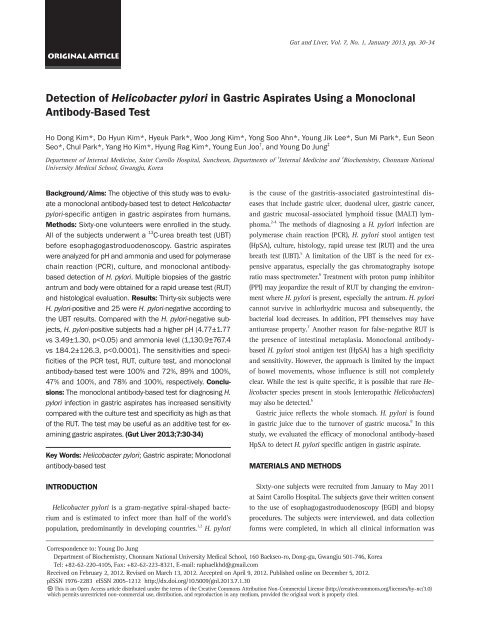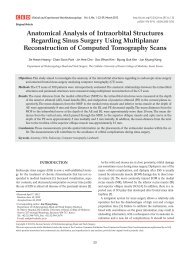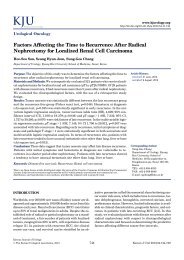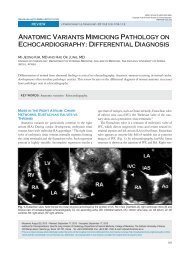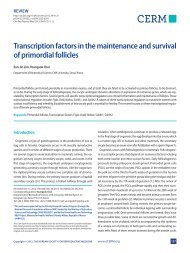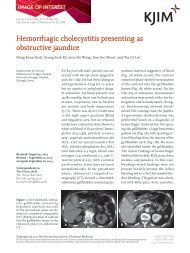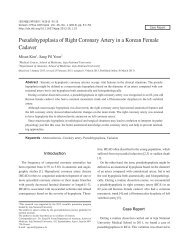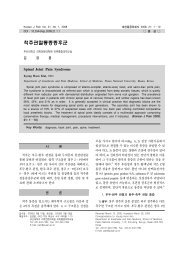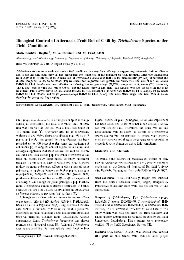Detection of Helicobacter pylori in Gastric Aspirates Using a ...
Detection of Helicobacter pylori in Gastric Aspirates Using a ...
Detection of Helicobacter pylori in Gastric Aspirates Using a ...
You also want an ePaper? Increase the reach of your titles
YUMPU automatically turns print PDFs into web optimized ePapers that Google loves.
Gut and Liver, Vol. 7, No. 1, January 2013, pp. 30-34<br />
ORig<strong>in</strong>al Article<br />
<strong>Detection</strong> <strong>of</strong> <strong>Helicobacter</strong> <strong>pylori</strong> <strong>in</strong> <strong>Gastric</strong> <strong>Aspirates</strong> Us<strong>in</strong>g a Monoclonal<br />
Antibody-Based Test<br />
Ho Dong Kim*, Do Hyun Kim*, Hyeuk Park*, Woo Jong Kim*, Yong Soo Ahn*, Young Jik Lee*, Sun Mi Park*, Eun Seon<br />
Seo*, Chul Park*, Yang Ho Kim*, Hyung Rag Kim*, Young Eun Joo † , and Young Do Jung ‡<br />
Department <strong>of</strong> Internal Medic<strong>in</strong>e, Sa<strong>in</strong>t Carollo Hospital, Suncheon, Departments <strong>of</strong> † Internal Medic<strong>in</strong>e and ‡ Biochemistry, Chonnam National<br />
University Medical School, Gwangju, Korea<br />
Background/Aims: The objective <strong>of</strong> this study was to evaluate<br />
a monoclonal antibody-based test to detect <strong>Helicobacter</strong><br />
<strong>pylori</strong>-specific antigen <strong>in</strong> gastric aspirates from humans.<br />
Methods: Sixty-one volunteers were enrolled <strong>in</strong> the study.<br />
All <strong>of</strong> the subjects underwent a 13 C-urea breath test (UBT)<br />
before esophagogastroduodenoscopy. <strong>Gastric</strong> aspirates<br />
were analyzed for pH and ammonia and used for polymerase<br />
cha<strong>in</strong> reaction (PCR), culture, and monoclonal antibodybased<br />
detection <strong>of</strong> H. <strong>pylori</strong>. Multiple biopsies <strong>of</strong> the gastric<br />
antrum and body were obta<strong>in</strong>ed for a rapid urease test (RUT)<br />
and histological evaluation. Results: Thirty-six subjects were<br />
H. <strong>pylori</strong>-positive and 25 were H. <strong>pylori</strong>-negative accord<strong>in</strong>g to<br />
the UBT results. Compared with the H. <strong>pylori</strong>-negative subjects,<br />
H. <strong>pylori</strong>-positive subjects had a higher pH (4.77±1.77<br />
vs 3.49±1.30, p
Kim HD, et al: <strong>Helicobacter</strong> <strong>pylori</strong> <strong>in</strong> <strong>Gastric</strong> Aspirate 31<br />
recorded. The subjects were excluded from the study if they had<br />
taken antibiotics, PPI or bismuth compounds <strong>in</strong> the previous 2<br />
weeks, or had undergone treatment for H. <strong>pylori</strong>. The subjects<br />
with renal <strong>in</strong>sufficiency or liver cirrhosis were also excluded.<br />
The subjects were evaluated for H. <strong>pylori</strong> status by the UBT<br />
us<strong>in</strong>g film coated 13 C-urea tablets. Breath samples were collected<br />
at 0 and 20 m<strong>in</strong>utes after adm<strong>in</strong>istration <strong>of</strong> a UBT tablet, and<br />
δ- 13 CO 2 (UBT value) was measured by <strong>in</strong>frared spectrometry us<strong>in</strong>g<br />
a UbiT-IR300 (Otsuka Pharmaceutical, Tokushima, Japan).<br />
The cut-<strong>of</strong>f value for the UBT was 2.5% at 20 m<strong>in</strong>utes. When<br />
UBT values were
32 Gut and Liver, Vol. 7, No. 1, January 2013<br />
Table 1. Characteristics <strong>of</strong> the Subjects Accord<strong>in</strong>g to the Urea Breath<br />
Test Results<br />
Characteristic<br />
Male,<br />
No.<br />
Female,<br />
No.<br />
Total,<br />
No.<br />
Age,<br />
mean±SD, yr*<br />
H. <strong>pylori</strong>-positive 18 8 26 40.7±11.2<br />
H. <strong>pylori</strong>-negative 9 5 14 36.7±8.6<br />
Total 27 13 40 38.0±12.0<br />
H. <strong>pylori</strong>, <strong>Helicobacter</strong> <strong>pylori</strong>.<br />
*p>0.05.<br />
Table 2. <strong>Gastric</strong> Aspirate pH Values and Ammonia Levels<br />
pH<br />
Ammonia*<br />
H. <strong>pylori</strong>-positive 4.77±1.77 1,130.9±767.4<br />
H. <strong>pylori</strong>-negative 3.49±1.30 184.2±126.3<br />
p-value
Kim HD, et al: <strong>Helicobacter</strong> <strong>pylori</strong> <strong>in</strong> <strong>Gastric</strong> Aspirate 33<br />
Table 4. Results <strong>of</strong> the Diagnostic Tests for <strong>Helicobacter</strong> <strong>pylori</strong> Infection<br />
Based on the Urea Breath Test Results<br />
Sensitivity<br />
Specificity<br />
Positive Negative<br />
predictive predictive<br />
value value<br />
Monoclonal antibody test 78 100 100 76<br />
Rapid urease test 89 100 100 86<br />
Culture 47 100 100 57<br />
Polymerase cha<strong>in</strong> reaction 100 72 84 100<br />
Data are presented <strong>in</strong> percentage.<br />
ulcer is active or <strong>in</strong> remission, patients with low grade MALT<br />
lymphoma, and patients who have undergone resection <strong>of</strong> early<br />
gastric cancer. 9 Therefore, EGD is required for both diagnosis <strong>of</strong><br />
gastroduodenal disease and documentation <strong>of</strong> H. <strong>pylori</strong> <strong>in</strong>fection.<br />
RUT has been widely used because it is simple, cheap, and<br />
easy to carry out. 10 But, a limitation to RUT is the bacterial<br />
load necessary to obta<strong>in</strong> sufficient sensitivity. A semiquantitative<br />
evaluation <strong>of</strong> the bacteria by histology clearly showed that<br />
false-negative urease tests corresponded to the lowest histological<br />
scores for H. <strong>pylori</strong>. 11-13 Another limitation is the sampl<strong>in</strong>g<br />
from only a small part <strong>of</strong> the stomach (i.e., a few mm 2 <strong>of</strong> a total<br />
surface area <strong>of</strong> 800 cm 2 ), which can lead to possible sampl<strong>in</strong>g<br />
errors and the subsequent need to do several biopsies. 14 Another<br />
reason for a false-negative test is the presence <strong>of</strong> <strong>in</strong>test<strong>in</strong>al<br />
metaplasia, which also corresponds to an <strong>in</strong>hospitable environment<br />
for H. <strong>pylori</strong>. Dyes used dur<strong>in</strong>g chromoendoscopy, such as<br />
methylene blue, may result <strong>in</strong> false-positive RUQ, therefore, the<br />
specimens for this test must be taken before spray<strong>in</strong>g the dyes. 15<br />
RUT takes 1 to 24 hours to complete. For rout<strong>in</strong>e use, most endoscopists<br />
read RUT results earlier than recommended, which<br />
leads to a marked decrease (20%) <strong>in</strong> sensitivity. 16<br />
Among the non<strong>in</strong>vasive <strong>in</strong>direct tests, UBT has the best sensitivity<br />
<strong>of</strong> approximately 95%. 17 However, false-negative results<br />
may also occur when PPI and antibiotics are used. UBT should<br />
be performed to detect H. <strong>pylori</strong> separately after EGD <strong>in</strong> patients<br />
with gastroduodenal diseases.<br />
HpSA has the advantage <strong>of</strong> be<strong>in</strong>g a direct non<strong>in</strong>vasive test<br />
because it detects H. <strong>pylori</strong> antigens <strong>in</strong> an easily-obta<strong>in</strong>ed specimen.<br />
18,19 The monoclonal antibody-based HpSA has a high<br />
specificity and sensitivity. However, the lowest concentration<br />
could not be detected after only a 24-hour delay <strong>in</strong> experimentally<br />
spiked specimens. 20 Treatment with the mucolytic agent<br />
N-acetylcyste<strong>in</strong>e decreases both the specificity and sensitivity. 21<br />
While the test is quite specific, it is possible that rare <strong>Helicobacter</strong><br />
species present <strong>in</strong> stools may also be detected.<br />
<strong>Gastric</strong> juice represents a pooled source <strong>of</strong> events <strong>in</strong> the entire<br />
gastric microenvironment, and it may be valuable for study<strong>in</strong>g H.<br />
<strong>pylori</strong> whose mucosal distribution is patchy and variable. <strong>Gastric</strong><br />
juice allows the detection <strong>of</strong> H. <strong>pylori</strong> by culture, sta<strong>in</strong><strong>in</strong>g,<br />
urease test, and PCR because H. <strong>pylori</strong> is found <strong>in</strong> gastric juice<br />
due to the turnover <strong>of</strong> gastric mucosa. But the culture sensitivity<br />
from gastric juice is much lower. 8 In addition, the culture is<br />
laborious and requires several days. <strong>Gastric</strong> juice PCR is highly<br />
sensitive and specific. 22 However, the possibility <strong>of</strong> false positives<br />
arises when endoscopes or gr<strong>in</strong>d<strong>in</strong>g apparati <strong>in</strong> the lab are<br />
not correctly cleaned and PCR is laborious as well. 23<br />
The results <strong>of</strong> this study demonstrated that H. <strong>pylori</strong>-specific<br />
antigen <strong>in</strong> gastric juice can be detected by a monoclonal antibody-based<br />
immunochromatographic assay. The specificity <strong>of</strong><br />
the monoclonal antibody-based test was higher than PCR and<br />
the sensitivity <strong>of</strong> it was higher than culture as well. Additionally,<br />
the monoclonal antibody-based test is cheap, easy to perform,<br />
is not time-consum<strong>in</strong>g when compared with culture and<br />
PCR. Although the sensitivity <strong>of</strong> monoclonal antibody-based<br />
test <strong>in</strong> this study was marg<strong>in</strong>ally lower than RUT, the specificity<br />
was the same. In addition, it did not require biopsy and posed<br />
no risk <strong>of</strong> serious biopsy-related complications such as bleed<strong>in</strong>g.<br />
In conclusion, RUT may not be able to detect the presence <strong>of</strong> H.<br />
<strong>pylori</strong> due to false negative, whereas gastric juice, be<strong>in</strong>g a more<br />
global sample, may overcome this limitation because gastric<br />
juice reflects the actual microenvironment and the global level<br />
<strong>of</strong> <strong>in</strong>fection <strong>in</strong> the stomach. Monoclonal antibody-based test<br />
from gastric aspirate may be useful for H. <strong>pylori</strong> detection as an<br />
additive test. This is the first study to detect H. <strong>pylori</strong> by monoclonal<br />
antibody-based test <strong>in</strong> gastric aspirate. Further studies are<br />
warranted to clarify the role <strong>of</strong> monoclonal antibody-based test<br />
<strong>in</strong> gastric aspirate.<br />
CONFLICTS OF INTEREST<br />
No potential conflict <strong>of</strong> <strong>in</strong>terest relevant to this article was<br />
reported.<br />
REFERENCES<br />
1. Goodw<strong>in</strong> CS, Mendall MM, Northfield TC. <strong>Helicobacter</strong> <strong>pylori</strong> <strong>in</strong>fection.<br />
Lancet 1997;349:265-269.<br />
2. Correa P, Piazuelo MB. Evolutionary history <strong>of</strong> the <strong>Helicobacter</strong><br />
<strong>pylori</strong> genome: implications for gastric carc<strong>in</strong>ogenesis. Gut Liver<br />
2012;6:21-28.<br />
3. Blaser MJ. Ecology <strong>of</strong> <strong>Helicobacter</strong> <strong>pylori</strong> <strong>in</strong> the human stomach.<br />
J Cl<strong>in</strong> Invest 1997;100:759-762.<br />
4. Suzuki H, Saito Y, Hibi T. <strong>Helicobacter</strong> <strong>pylori</strong> and gastric mucosaassociated<br />
lymphoid tissue (MALT) lymphoma: updated review<br />
<strong>of</strong> cl<strong>in</strong>ical outcomes and the molecular pathogenesis. Gut Liver<br />
2009;3:81-87.<br />
5. Rautel<strong>in</strong> H, Lehours P, Mégraud F. Diagnosis <strong>of</strong> <strong>Helicobacter</strong> <strong>pylori</strong><br />
<strong>in</strong>fection. <strong>Helicobacter</strong> 2003;8 Suppl 1:13-20.<br />
6. Mégraud F, Lehours P. <strong>Helicobacter</strong> <strong>pylori</strong> detection and antimicrobial<br />
susceptibility test<strong>in</strong>g. Cl<strong>in</strong> Microbiol Rev 2007;20:280-322.<br />
7. Tsuchiya M, Imamura L, Park JB, Kobashi K. <strong>Helicobacter</strong> <strong>pylori</strong>
34 Gut and Liver, Vol. 7, No. 1, January 2013<br />
urease <strong>in</strong>hibition by rabeprazole, a proton pump <strong>in</strong>hibitor. Biol<br />
Pharm Bull 1995;18:1053-1056.<br />
8. Varoli O, Land<strong>in</strong>i MP, LaPlaca M, et al. Presence <strong>of</strong> <strong>Helicobacter</strong><br />
<strong>pylori</strong> <strong>in</strong> gastric juice. Am J Gastroenterol 1991;86:249.<br />
9. Chey WD, Wong BC; Practice Parameters Committee <strong>of</strong> the<br />
American College <strong>of</strong> Gastroenterology. American College <strong>of</strong> Gastroenterology<br />
guidel<strong>in</strong>e on the management <strong>of</strong> <strong>Helicobacter</strong> <strong>pylori</strong><br />
<strong>in</strong>fection. Am J Gastroenterol 2007;102:1808-1825.<br />
10. Pr<strong>in</strong>ce MI, Osborne JS, Ingoe L, Jones DE, Cobden I, Barton JR.<br />
The CLO test <strong>in</strong> the UK: <strong>in</strong>appropriate read<strong>in</strong>g and missed results.<br />
Eur J Gastroenterol Hepatol 1999;11:1251-1254.<br />
11. Tokunaga Y, Shirahase H, Yamamoto E, et al. Modified rapid urease<br />
test for <strong>Helicobacter</strong> <strong>pylori</strong> detection <strong>in</strong> relation to an immunohistochemical<br />
sta<strong>in</strong>. J Gastroenterol Hepatol 2000;15:617-621.<br />
12. Zaitoun AM. Histology compared with chemical test<strong>in</strong>g for urease<br />
for rapid detection <strong>of</strong> <strong>Helicobacter</strong> <strong>pylori</strong> <strong>in</strong> gastric biopsy specimens.<br />
J Cl<strong>in</strong> Pathol 1993;46:684-685.<br />
13. Borromeo M, Lambert JR, P<strong>in</strong>kard KJ. Evaluation <strong>of</strong> “CLO-test”<br />
to detect Campylobacter <strong>pylori</strong>dis <strong>in</strong> gastric mucosa. J Cl<strong>in</strong> Pathol<br />
1987;40:462-463.<br />
14. Cox AJ. Stomach size and its relation to chronic peptic ulcer.<br />
AMA Arch Pathol 1952;54:407-422.<br />
15. Hack HM, Parsonnet J, Triadafilopoulos G. Test<strong>in</strong>g negative for<br />
<strong>Helicobacter</strong> <strong>pylori</strong> after methylene blue spray<strong>in</strong>g <strong>of</strong> gastric mucosa.<br />
Gastro<strong>in</strong>test Endosc 1994;40:397-398.<br />
16. La<strong>in</strong>e L, Lew<strong>in</strong> D, Naritoku W, Estrada R, Cohen H. Prospective<br />
comparison <strong>of</strong> commercially available rapid urease tests for the<br />
diagnosis <strong>of</strong> <strong>Helicobacter</strong> <strong>pylori</strong>. Gastro<strong>in</strong>test Endosc 1996;44:523-<br />
526.<br />
17. Gisbert JP, Pajares JM. Review article: 13C-urea breath test <strong>in</strong> the<br />
diagnosis <strong>of</strong> <strong>Helicobacter</strong> <strong>pylori</strong> <strong>in</strong>fection: a critical review. Aliment<br />
Pharmacol Ther 2004;20:1001-1017.<br />
18. Makristathis A, Barousch W, Pasch<strong>in</strong>g E, et al. Two enzyme immunoassays<br />
and PCR for detection <strong>of</strong> <strong>Helicobacter</strong> <strong>pylori</strong> <strong>in</strong> stool<br />
specimens from pediatric patients before and after eradication<br />
therapy. J Cl<strong>in</strong> Microbiol 2000;38:3710-3714.<br />
19. Agha-Amiri K, Peitz U, Ma<strong>in</strong>z D, Kahl S, Leodolter A, Malferthe<strong>in</strong>er<br />
P. A novel immunoassay based on monoclonal antibodies<br />
for the detection <strong>of</strong> <strong>Helicobacter</strong> <strong>pylori</strong> antigens <strong>in</strong> human stool. Z<br />
Gastroenterol 2001;39:555-560.<br />
20. Monteiro L, Gras N, Vidal R, Cabrita J, Megraud F. <strong>Detection</strong> <strong>of</strong><br />
<strong>Helicobacter</strong> <strong>pylori</strong> DNA <strong>in</strong> human feces by PCR: DNA stability<br />
and removal <strong>of</strong> <strong>in</strong>hibitors. J Microbiol Methods 2001;45:89-94.<br />
21. Demirtürk L, Yazgan Y, Tarc<strong>in</strong> O, et al. Does N-acetyl cyste<strong>in</strong> affect<br />
the sensitivity and specificity <strong>of</strong> <strong>Helicobacter</strong> <strong>pylori</strong> stool antigen<br />
test? <strong>Helicobacter</strong> 2003;8:120-123.<br />
22. Yakoob J, Rasool S, Abbas Z, et al. <strong>Gastric</strong> juice for the diagnosis<br />
<strong>of</strong> H. <strong>pylori</strong> <strong>in</strong>fection <strong>in</strong> patients on proton pump <strong>in</strong>hibitors. World<br />
J Gastroenterol 2008;14:1539-1543.<br />
23. Roosendaal R, Kuipers EJ, van den Brule AJ, et al. Importance <strong>of</strong><br />
the fiberoptic endoscope clean<strong>in</strong>g procedure for detection <strong>of</strong> <strong>Helicobacter</strong><br />
<strong>pylori</strong> <strong>in</strong> gastric biopsy specimens by PCR. J Cl<strong>in</strong> Microbiol<br />
1994;32:1123-1126.


